Worn teeth – teeth clenching, bruxism
Dentysta stomatolog Warszawa Ursynów ADENTIS / Services / Rehabilitation of temporomandibular joints / Worn teeth – teeth clenching, bruxism
Wearing teeth – jaw clenching, bruxism
 |
Tooth wear is considered a continuous and irreversible physiological phenomenon that occurs with age and proper chewing function. It is approximately 65nm per year. In conditions of proper bite, the tooth wears out the fastest, followed by the incisors. Pathological attrition is excessive, atypical and age-inappropriate loss of hard tissue due to non-carious causes. It may affect individual teeth, groups of teeth or the entire dentition.
Pathological tooth wear, along with atherosclerosis, diabetes and hypertension, can be considered a lifestyle disease.
An increasing percentage of the population is struggling with this problem.
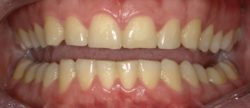

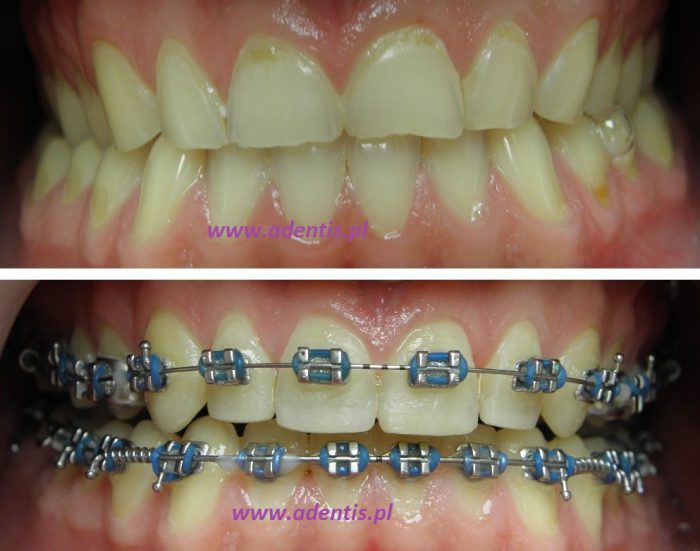
Tooth abrasion is divided into:
- Night gnashing of teeth.
- Subconscious clenching of teeth.
 |
 |

Tooth wear may affect the front or side teeth. (according to Jose dos Santos “Occlusion – Principles &Treatment”)
Consequences of clenching on front teeth:

clenching on the back teeth:

The prevention and treatment of jaw clenching and its complications are of key importance in 21st century dentistry, because it is currently the most common occlusal parafunction that destroys the entire stomatognathic system.
Stomatognathic system – a morphological and functional complex of tissues and organs in the oral cavity and facial skeleton, constituting a functional whole and involved in food intake (chewing, initial digestion and swallowing), articulation of sounds, breathing and expression of emotions.
These include:
- teeth with periodontium,
- articulation and occlusal complex – the arrangement of teeth in the upper and lower dental arch,
- both functionally coupled temporomandibular joints and also including the masticatory muscles,
- other tissues and organs of the oral cavity and face: facial bones, muscles (masseter, suprahyoid, facial muscles, tongue and palate), blood and lymphatic vessels, nerves, mucous membrane and salivary glands
under the control of the central nervous system.
There are two occlusal parafunctions:
- teeth clenching
- teeth grinding
Non-occlusal parafunctions also occur, both in the diagnosis and treatment of masticatory organ dysfunction syndrome, and may be the only reason for difficulties in treatment and may cause recurrence of symptoms. Clinical observations in recent years indicate that patients under 18 years of age are increasingly seeking treatment for masticatory system dysfunction.
However,bruxismis a disease with a complex psychological and somatic basis, with an occlusal component.
For many people, teeth clenching is an unconscious habit. These people may not even be aware that they have a disorder until someone tells them that they grind their teeth loudly while sleeping. For others, a routine dental checkup reveals that the teeth are worn down or the enamel on them is damaged.
The forces acting in the oral cavity are so great that if the entire stomatognathic system (teeth, muscles, bone) is not in balance, it leads to destruction. This can only be remedied by rebuilding the entire system, not a single tooth. Only interdisciplinary treatment can protect teeth
 |
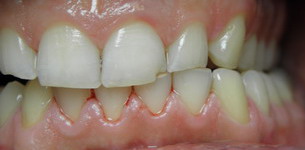 |
| Pathological tooth wear | Pathological tooth wear |
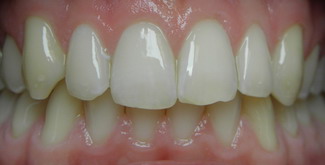 |
 |
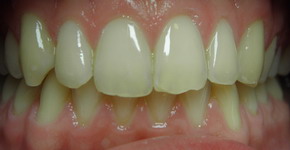 |
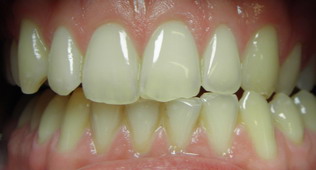 |
Abrasion of the left upper central incisor caused by teeth grinding.
According to some statistics, as many as 7 out of 10 people suffer from teeth clenching problems. Jaw clenching is a parafunctional reflex. It is not seen as a bad habit. Dental contacts occur only when swallowing food or swallowing saliva. The act of swallowing saliva occurs at a frequency of 1,500-2,000 times per 24 hours. During the day, dental contacts are short, about 30 minutes a day.
All other interdental contacts are pathologies that may lead to:
- abrasion of the occlusal surfaces of the teeth, which contributes to a change in the height of the occlusion,
- fractures of tooth crowns,
- changes in the enamel, including: wedge (cervical) defects
- damage to prosthetic crowns,
- increased tooth mobility,
- uncontrolled tooth displacements in the arch,
- apparent tooth eruption,
- Pathologies in the temporomandibular joint (the fibers in the joint lose their elastic properties, are stretched and the articular disc may be distorted)
- growth and hypertrophy of the muscles responsible for chewing, mainly the masseter muscle, may cause visible asymmetry of the lower part of the face.
The patient, not suspecting that the cause of the ailment is teeth, often goes to doctors of other specialties, most often an otolaryngologist, neurologist and ophthalmologist.
Symptoms of teeth clenching include:
- Systemic symptoms such as:
- headaches
- neck and back pain
- ear pain, hearing disorders
- disorders in the production of saliva by the salivary glands
- Symptoms of facial muscles and shoulder girdle:
- hypertrophy of the masseter and temporalis muscles (so-called square face)
- pain around the attachments of the masseter and temporalis muscles
- increased tension in the shoulder girdle, especially the sternocleidomastoid muscle
- pain in the shoulder girdle and hand and paresthesia
- Oral symptoms:
- abrasion discs – the effect of tooth wear (visible during a dental examination)
- maceration and anemization of the buccal and tongue mucosa in the bite line
- periodontal loss, exposure of tooth roots
- frequent bleeding when brushing teeth
Pathological hypertrophy of the masseter muscle caused by excessive teeth clenching.

Appropriate treatment depends on what is causing the problem. After asking the right questions and examining your teeth, your dentist can help determine the potential source of the disease. Depending on the extent of tooth damage and its likely cause, your dentist may recommend:
- Putting on an appropriate overlay (splint) during sleep – This overlay, custom-made by the dentist to fit the teeth exactly, is slipped over the upper teeth and protects them against friction against the lower teeth. Although such an overlay effectively prevents the consequences of bruxism, it does not cure its cause.
- Finding ways to relax – Since everyday stress seems to be the main cause of bruxism, anything that reduces stress – listening to music, reading a book, going for a walk or taking a bath – can be helpful. You can also benefit from learning effective ways to deal with stressful situations. Additionally, placing a warm, damp cloth on the side of your face can help relax the sore muscles caused by clenching your teeth.
- Reduction of “prominent points” on one or more teeth to even out the bite. A misbite, where teeth do not fit neatly together, can also be corrected with new fillings, crowns or orthodontic methods.
 |
|
| Relaxation splint | Relaxation splint on the model |
First of all, you need to fight the cause, not the effect.
ADENTISWELCOME
